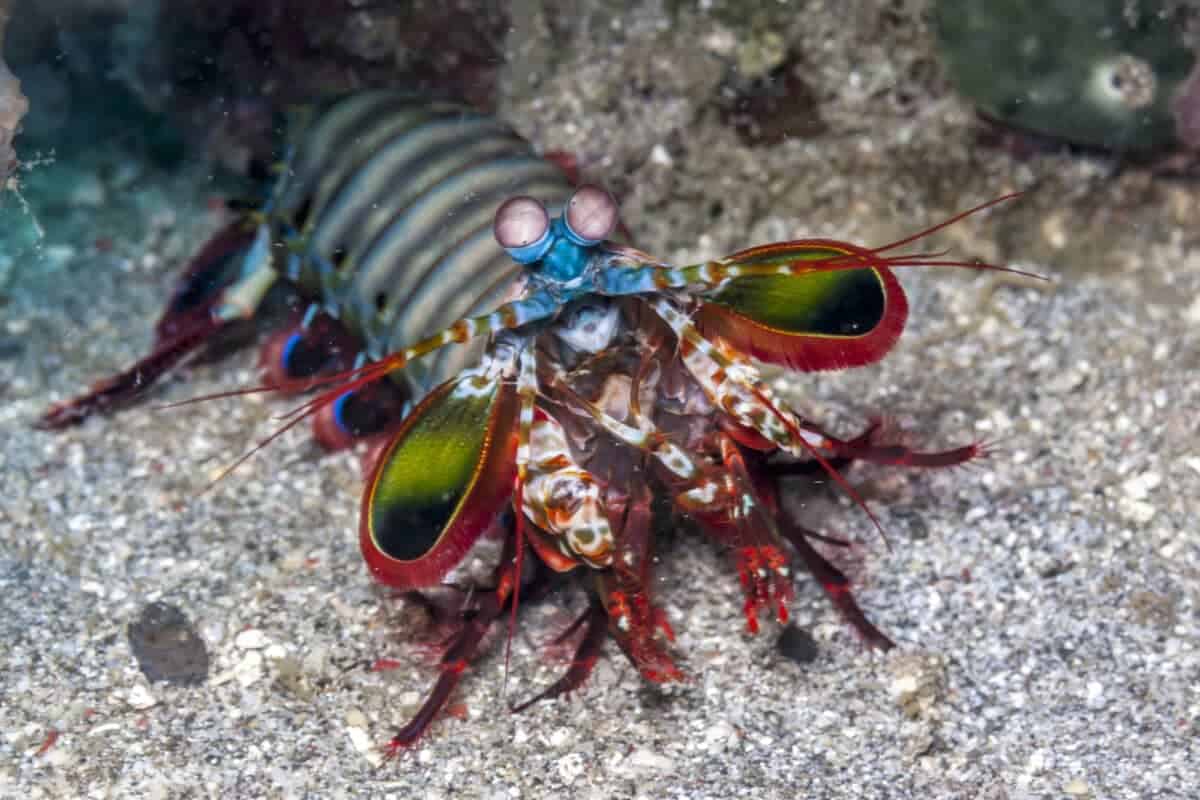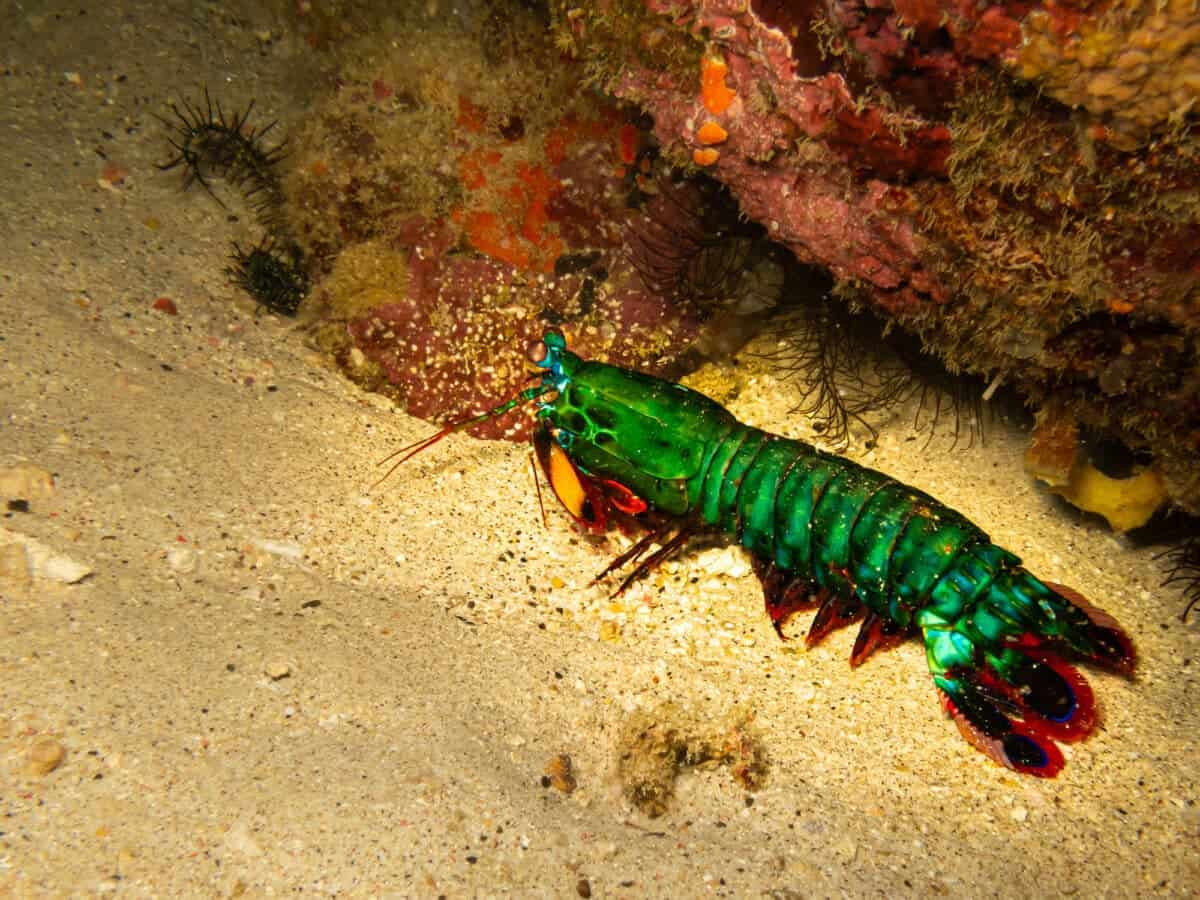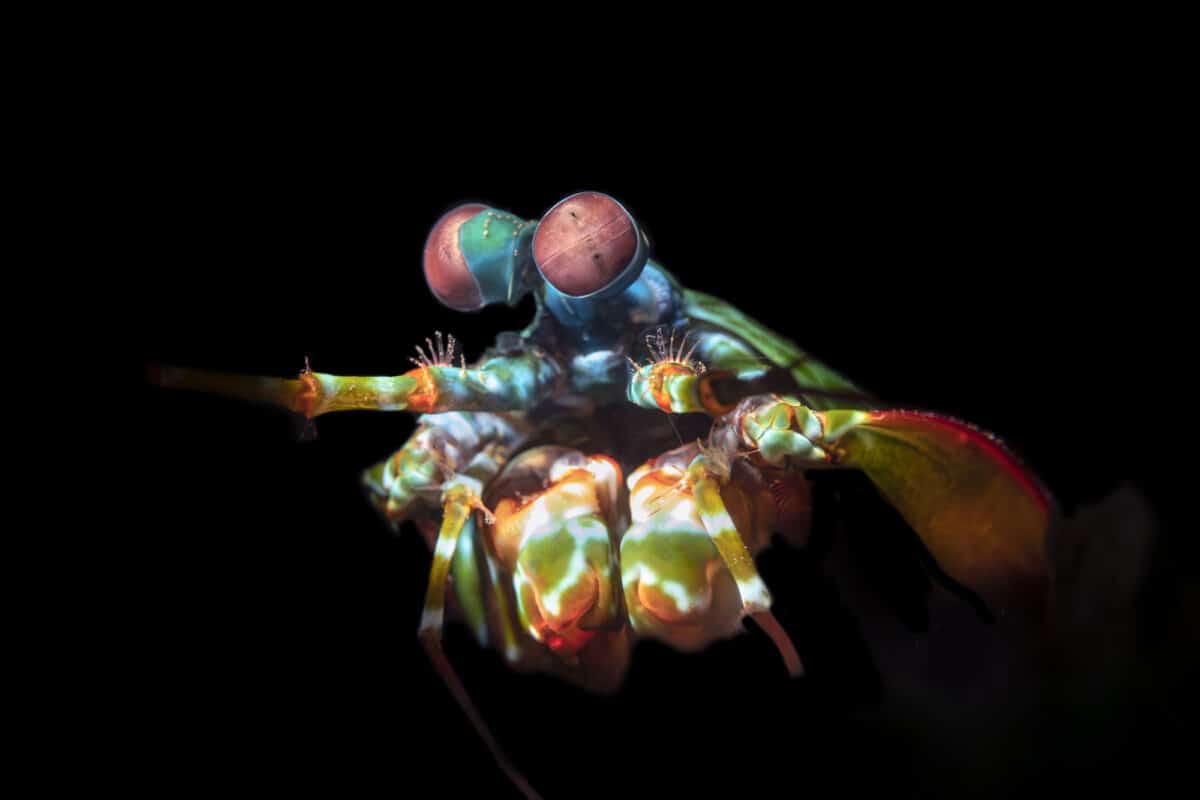Beneath the waves of tropical and subtropical waters dwells one of nature’s most extraordinary creatures—the mantis shrimp. Despite its modest size, typically ranging from 2 to 7 inches in length, this crustacean possesses an ability that defies our understanding of physics and biology: it can strike with its specialized appendages at speeds faster than a bullet. These marine marvels, belonging to the order Stomatopoda, have evolved one of the most powerful and rapid attack mechanisms in the animal kingdom. With over 450 species identified, mantis shrimps have developed specialized hunting techniques that have fascinated scientists for decades. Their remarkable punching ability has inspired innovations in materials science, military technology, and even medical devices. This article explores the extraordinary biomechanics that enable the mantis shrimp to deliver one of nature’s most formidable blows.
The Astonishing Speed: Breaking Down the Numbers

The mantis shrimp’s strike is a true marvel of natural engineering, achieving speeds that seem impossible for a creature of its size. These crustaceans can accelerate their striking appendages to speeds of 23 meters per second (about 51 mph), generating forces exceeding 1,500 newtons—more than 2,500 times the shrimp’s body weight. To put this in perspective, if humans could punch with equivalent force relative to our body weight, we could break through steel.
The acceleration of this strike reaches an astounding 10,400 g (where g is the acceleration due to gravity), making it one of the fastest movements in the animal kingdom. For comparison, a .22 caliber bullet travels at approximately 340 meters per second—while obviously faster in absolute terms, the mantis shrimp’s achievement is remarkable considering its size and the medium in which it operates. Water creates approximately 900 times more drag than air, making the shrimp’s speed even more impressive.
The Specialized Weaponry: Dactyl Clubs and Spears

Mantis shrimps have evolved two primary types of specialized striking appendages, dividing them into “smashers” and “spearers.” Smashers possess rounded, hammer-like dactyl clubs used to crush hard-shelled prey like clams, snails, and crabs. These clubs are composed of highly specialized materials arranged in a complex structure that prevents them from fracturing despite the tremendous forces generated. Spearers, on the other hand, have developed sharp, barbed appendages designed to impale soft-bodied prey like fish.
Both types of weapons are modified from the second pair of thoracic appendages, known as maxillipeds. These appendages contain specialized joints and muscle arrangements that enable the extraordinary striking mechanism. The surface of the dactyl club in smashers is particularly remarkable, featuring an outer layer of hydroxyapatite (the same mineral found in human teeth) arranged in a complex crystalline structure that provides exceptional hardness and impact resistance while remaining relatively lightweight.
The Power-Amplification Mechanism: Nature’s Crossbow

The secret behind the mantis shrimp’s incredible striking speed lies in its specialized power-amplification mechanism, which functions similar to a crossbow. Unlike typical movements that rely directly on muscle contractions, the mantis shrimp employs a unique energy storage and release system. The process begins when the shrimp contracts its muscles slowly, building up energy by compressing a specialized structure similar to a spring. This energy-storing “spring” consists of a saddle-shaped structure made of chitin (the same material that forms the exoskeletons of insects and crustaceans) that becomes compressed as muscles pull on it.
When the shrimp is ready to strike, a latch mechanism—comparable to a trigger—releases the stored energy, allowing the appendage to accelerate at phenomenal speeds. This mechanism effectively converts the relatively slow power of muscle contraction into an explosive release of energy, achieving accelerations far beyond what would be possible with direct muscle action alone. Scientists have calculated that only about 10% of the strike’s energy comes from direct muscle power—the remaining 90% comes from this remarkable energy storage system.
Cavitation Bubbles: The Double-Punch Effect

Perhaps one of the most fascinating aspects of the mantis shrimp’s strike is the generation of cavitation bubbles—a phenomenon that essentially creates a secondary impact. As the club moves through water at such extreme speeds, it creates areas of low pressure behind it. This pressure drop is so dramatic that it causes the water to momentarily vaporize, forming bubbles that almost immediately collapse when surrounding water rushes in to fill the void. This collapse generates localized shock waves, temperatures approaching those on the sun’s surface (estimated at around 4,400°C or 8,000°F), and even small bursts of light through a process called sonoluminescence.
The combination of the initial physical impact and the subsequent cavitation bubble collapse delivers a devastating one-two punch to prey. This secondary strike can reach forces of up to 280% of the initial impact, meaning the prey is effectively hit twice from a single strike. The collapsing bubbles also produce a distinctive “snap” sound that gives the mantis shrimp its nickname: the “pistol shrimp” (though true pistol shrimps are actually a different species that uses a similar cavitation mechanism).
The Ultra-Durable Structure: Building the Perfect Weapon

The mantis shrimp’s striking appendage represents one of nature’s most sophisticated biological structures, designed to withstand forces that would shatter most materials. The club of “smasher” mantis shrimps is composed of three specialized regions working in concert. The outer impact region contains a high concentration of hydroxyapatite crystals arranged in a helical structure that dissipates impact energy and prevents crack propagation. Beneath this lies the periodic region, featuring layers of chitin fibers arranged in a Bouligand structure—a helicoidal pattern where each layer is rotated slightly relative to the one below it.
This arrangement distributes impact forces and prevents cracks from spreading through the structure. The innermost striated region contains chitin fibers aligned parallel to the impact surface, adding further structural support. Together, these regions create a club that can deliver thousands of powerful blows without damage. This remarkable material has inspired engineers to develop new impact-resistant materials for applications ranging from body armor to aerospace components. The mantis shrimp can deliver up to 50,000 strikes during its lifetime without needing to repair or replace its club—a testament to the exceptional durability of this natural weapon.
The Extraordinary Visual System: Seeing the Strike

Complementing its remarkable striking ability, the mantis shrimp possesses one of the most complex visual systems in the animal kingdom, which plays a crucial role in targeting and executing its lightning-fast attacks. While humans have three types of color-receptive cones in our eyes, mantis shrimps have up to 16 different photoreceptor types, including the ability to see ultraviolet, infrared, and polarized light. Their eyes sit on mobile stalks and can move independently of each other, providing exceptional depth perception and a wide field of view.
Each eye is divided into three regions, allowing the shrimp to see the same point with different parts of the same eye—a form of trinocular vision within a single eye. This extraordinary visual system enables the mantis shrimp to precisely target vulnerable points on prey shells, assess the thickness and composition of potential prey’s armor, and time its strike with remarkable accuracy. The visual processing occurs primarily in the eyes themselves rather than the brain, allowing for faster reaction times and more efficient neural processing—essential adaptations for a predator that relies on split-second attacks.
Evolutionary Development: The Arms Race Under the Sea

The mantis shrimp’s remarkable striking mechanism represents millions of years of evolutionary adaptation in response to predator-prey arms races. Fossil evidence suggests that stomatopods diverged from other crustaceans approximately 400 million years ago, with specialized striking appendages appearing in the fossil record around 170 million years ago. The development of hard-shelled prey with increasingly robust defenses likely drove the evolution of the mantis shrimp’s powerful strike as a counter-adaptation.
Different mantis shrimp species have evolved variations on this striking mechanism based on their preferred prey and habitats. The specialization between “smashers” and “spearers” represents different evolutionary solutions to the challenge of capturing prey. Interestingly, molecular studies suggest that the specialized striking appendage evolved only once in mantis shrimp ancestors, but has since diversified into various forms. This evolutionary history illustrates the principle of escalation in predator-prey relationships, where adaptations in one species drive counter-adaptations in others, leading to increasingly specialized and extreme biological features—a biological arms race that has produced one of nature’s most remarkable weapons.
Hunting Strategies: How the Strike is Deployed

The mantis shrimp employs sophisticated hunting strategies that leverage its remarkable striking ability. Most species are ambush predators, hiding in burrows or crevices in coral reefs, waiting to strike unsuspecting prey that wanders too close. Using their exceptional vision, they can detect and track prey with remarkable precision. When a suitable target approaches, the mantis shrimp launches its strike with extraordinary speed and accuracy.
“Smasher” species typically aim for specific weak points in the shells of their prey, maximizing the impact of their blow. Some species have been observed to “test” the thickness of prey shells with light taps before delivering a full-force strike. “Spearer” species use their barbed appendages to impale soft-bodied prey, often targeting specific vulnerable areas like the eyes or nervous system. The strike is so fast that prey typically has no time to react or escape. In laboratory settings, mantis shrimps have been observed breaking aquarium glass with their strikes—an indication of the raw power these animals can generate. Their hunting strategy is energy-efficient: rather than chasing prey, they conserve energy by waiting and then deploying a single, devastatingly effective strike.
The Biological Cost: Energy Expenditure and Recovery

The mantis shrimp’s remarkable striking ability comes with significant biological costs in terms of energy expenditure and recovery time. Generating such explosive force requires substantial energy investment, even with the mechanical advantage provided by the spring-loaded mechanism. After delivering a powerful strike, the mantis shrimp must undergo a recovery period to prepare for another attack. This recovery involves rebuilding the energy stored in the spring mechanism and resetting the latch system. The duration varies by species, but typically ranges from a few milliseconds to several seconds—an eternity in predator-prey interactions.
To sustain this energy-intensive hunting strategy, mantis shrimps have evolved efficient metabolic systems and tend to be opportunistic feeders, consuming a variety of prey to maintain their energy reserves. They also exhibit behavioral adaptations to manage energy expenditure, such as varying strike force based on prey type. Smaller prey might receive less powerful strikes, conserving energy for when it’s truly needed. Some species have developed specialized muscle fibers that allow for more efficient energy storage and quicker recovery between strikes. This balance between explosive power and energy management represents a fascinating evolutionary trade-off that has been finely tuned over millions of years.
Scientific Research and Discoveries: Unlocking the Secrets

The mantis shrimp’s extraordinary striking mechanism has been the subject of intensive scientific investigation, leading to numerous breakthroughs in our understanding of biomechanics and materials science. High-speed cameras capable of recording millions of frames per second have been essential in documenting the strike, revealing details invisible to the naked eye. Researchers like Dr. Sheila Patek at Duke University have pioneered much of the modern research on mantis shrimp biomechanics, using sophisticated equipment to measure the forces, speeds, and accelerations involved.
Studies using scanning electron microscopy and X-ray diffraction have revealed the complex microstructure of the dactyl club, while computational models have helped scientists understand how energy is stored and released during the strike. Research has also examined the neurological control mechanisms that allow such precise timing and targeting. In 2018, researchers at Singapore’s Nanyang Technological University discovered that the mantis shrimp’s dactyl club contains a previously unknown form of composite material that could inspire new industrial applications. More recent studies have focused on the genetic basis for these specialized structures, with scientists identifying key genes involved in the development of the striking appendage. These ongoing investigations continue to reveal new aspects of the mantis shrimp’s remarkable adaptations.
Biomimicry Applications: Inspired by the Punch

The mantis shrimp’s extraordinary striking mechanism and ultra-durable club structure have inspired numerous innovations in biomimicry—the practice of emulating nature’s designs to solve human problems. Engineers at the University of California, Riverside have developed impact-resistant materials based on the layered structure of the mantis shrimp’s dactyl club, creating composites that could potentially be used in body armor, vehicle frames, and sports equipment. The energy-storage mechanism has influenced the design of mechanical systems that require rapid deployment of force, such as surgical tools and industrial actuators.
Materials scientists have drawn inspiration from the helical arrangements of fibers in the club to create crack-resistant ceramics and composites with applications in aerospace and defense industries. The cavitation effect generated by the mantis shrimp’s strike has informed the development of more efficient underwater propulsion systems and has applications in medical procedures where controlled cavitation can be used to break up kidney stones or deliver targeted medications. Robotics engineers have created mechanical systems that mimic the spring-loaded striking mechanism, enabling small robots to generate forces far beyond what their motors could produce directly. Perhaps most intriguingly, researchers at Harvard University have developed a miniature robot called “Ninjabot” that replicates the mantis shrimp’s strike, allowing for more controlled studies of the biomechanics involved.
Conclusion: Nature’s Ultimate Striker

The mantis shrimp stands as one of nature’s most remarkable evolutionary achievements, a testament to the extraordinary adaptations that can emerge through millions of years of natural selection. Its ability to strike faster than a bullet while underwater represents a perfect convergence of specialized anatomy, efficient energy storage, and precision control systems. The complex structure of its striking appendage—with its specialized materials and architectural arrangements—demonstrates nature’s capacity to develop solutions that often surpass human engineering.
As we continue to study these remarkable creatures, we not only deepen our understanding of evolutionary biology and biomechanics but also find inspiration for new technologies that mimic nature’s innovations. The mantis shrimp reminds us that even in the most familiar environments, extraordinary adaptations exist that challenge our understanding of what’s physically possible, proving once again that nature remains our greatest teacher and source of wonder.
- This Fish Has the Most Teeth in the Ocean—And Uses Them Well - August 9, 2025
- How Wolves Use Group Howls to Reunite With Pups - August 9, 2025
- 12 Dog Breeds That Form the Deepest Emotional Bonds with Their Owners - August 9, 2025

